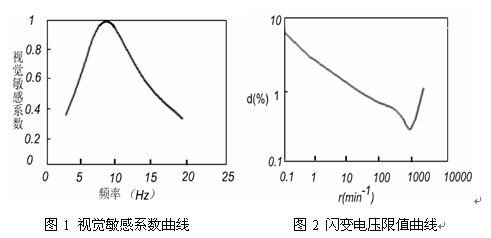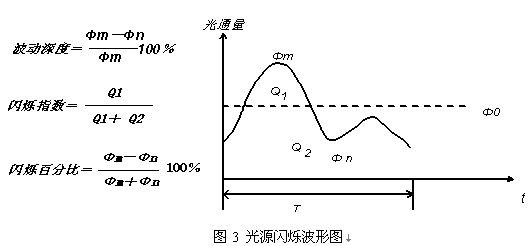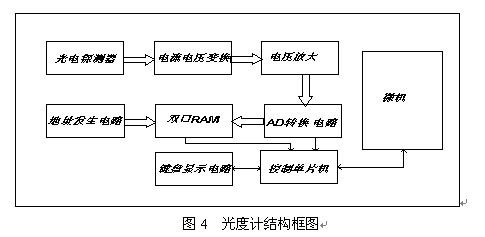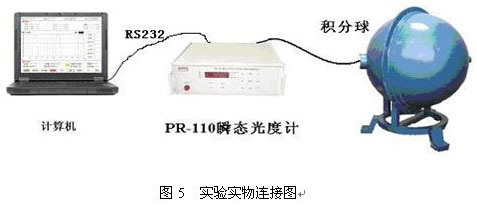Abstract : This paper introduces the basic concept of light source flicker, the causes, and discusses the various hazards of light source flicker and flicker effect. The evaluation method and measurement method of flicker are expounded. Finally, the scintillation intensity of several typical light sources is measured. The data and analysis results can be used as reference in health lighting.
Keywords : flicker stroboscopic effect, wave depth, transient photometer
one. Overview
1. Basic concept of flashing
It has been found that reading books under fluorescent light for a long time will be uncomfortable, although the brightness is the same as during the day. Why is this? After research, it turned out that this is because the light intensity of the fluorescent lamp changes with time. That is, the flashing of the light source.
So what is the light source flashing? The flashing of the light source is a rapid and repeated change of the light emitted by the light source over time, making the light source jump and unstable. Of course, the human eye does not easily perceive the flicker of the light source, which depends mainly on the frequency of the flicker. Generally, at a blinking frequency of 50 Hz or less, the human eye can perceive the flicker of the light source. At 8.8 Hz, the human eye is the most sensitive. At the same time, the maximum flicker frequency (critical flicker frequency) that can be perceived changes with the intensity of the light emitted by the light source. As the light intensity increases, the critical flicker frequency also increases. When the light intensity reaches a maximum, it gradually decreases. The critical flicker frequency is also reduced accordingly. When the light intensity changes at a frequency greater than 50 Hz, most people can't tell if the light source is flashing. At this time, the light source emits a steady, continuous light, because the reflection of the human eye can no longer keep up with the change of the light source. It is. For example, the human eye does not notice the flicker of a fluorescent lamp of 100 blinks per second (100 Hz).
Light source flicker can be confirmed by the stroboscopic effect. Sometimes we find a phenomenon in which when an object moves or rotates very quickly, they appear to move more slowly than they actually do, even when the object moves or rotates at the same frequency as the source (or an integer) When the relationship is doubled, the object seems to be stationary. This is the reason for the stroboscopic light, which is a phenomenon that we do not want to happen in everyday lighting. In fact, people have the illusion of stroboscopic effects, and it is very dangerous to think of some fast-moving devices as slow or even stationary.
There are many kinds of flashing lights, and the following are common:
1. Periodic flashing of illumination: such as stroboscopic flashing of AC fluorescent lamps and flickering of light source due to fluctuations in power supply voltage;
2. Illumination non-periodic flashing: If the AC fluorescent lamp starts to flash, various faults flash;
3. Display device flicker: such as flashing caused by scanning display of TV, computer, electronic game machine, advertising screen, etc.
4, art light flashes: such as neon lights, lights and lasers flashing.
2. The cause of the flashing of the light source
The flashing of the light source is essentially a subjective feeling of the reaction chain from the voltage fluctuation - the flux fluctuation - the eye to the human brain. The technical mechanism of stroboscopic generation has both the factors of power supply, the factors of electric light source performance, and the unreasonable factors of lighting design. In the following, general technical analysis will be carried out only from the perspective of technical performance of commonly used electric light sources.
(1) The power supply frequency of the light source is low. Incandescent lamps, high pressure mercury (sodium) lamps, straight tube (inductive) fluorescent lamps. At this stage, most of them are powered by a 50Hz power frequency sinusoidal alternating current directly to the illuminant of the electric light source. The stroboscopic frequency is 50 Hz*2=100 Hz, and it fluctuates in a sine wave pattern.
(2) The light source voltage fluctuates greatly. At present, the power frequency AC power supply in China has a transient voltage value fluctuation range of 10% to 20%, which greatly increases the stroboscopic depth with a frequency of 100 Hz and a sinusoidal wave.
(3) Electric light source performance. The incandescent lamp is a heat radiating light source that directly heats the filament, and the luminous power of the illuminating body fluctuates with a sine wave law in accordance with the frequency of the power supply. High-pressure mercury (sodium) lamp, straight tube type (inductive) fluorescent lamp, although it is an electric light source for gas discharge illumination. However, due to its start-up and ignition, inductive ballasts are used (the AC-DC-AC frequency conversion function is not available). Therefore, the discharge power of the gas discharge illuminator necessarily fluctuates with the frequency fluctuation of the power supply.
The effects of voltage fluctuations can be quantified using two concepts: the visual sensitivity coefficient curve and the flicker voltage limit curve.
The light source that can be perceived by the human eye flickers, and the sensation characteristic of the human eye to the light source flicker can be measured by a statistical method. Figure 1 is a plot of the visual sensitivity coefficient of the human eye for voltage fluctuations at different frequencies. It can be seen from the curve that the most sensitive frequency is 8.8 Hz, and after deviating from this frequency, the sensitivity decreases with frequency. When the flicker frequency is above 40 Hz, the feeling is not sensitive; the flicker above 50 Hz has no feeling at all.
Figure 2 is the flicker voltage limit curve given by IEC. It is mapped to the visual sensitivity coefficient curve, and the visually sensitive frequency is 8.8 Hz. At this time, the voltage variation d is the smallest, which is 0.29%. The curve is obtained under the action of a periodic rectangular (or step) voltage.

The voltage variation d represents the difference between the two adjacent extreme voltages, and is given as a percentage; the voltage variation frequency r represents the number of times of voltage fluctuation per unit time, in units of min-1.
two. Blinking harm to the human eye
The flickering of the light source is irritating to the human visual system and creates an uncomfortable feeling. People who work or live in the blinking light for a long time may also affect the physical and mental health of the visual system. The severity of this stimulating effect or effect is related to the intensity, frequency, duration of action, and long-term nature of the source's flicker. This effect is often slow, so it has not attracted people's attention for a long time. However, with the rapid development of electronic technology, people work under the AC fluorescent lamp and the display screen during the day; at night, under the AC fluorescent lamp and the TV screen, even with dazzling art lighting, the light source flickers the visual system. The impact of the problem is increasingly prominent.
In particular, the stroboscopic effect of electric light sources has caused serious harm to human production, daily life, and physical and mental health. Mainly in the following aspects:
1. The illusion causes an accident at work: when the stroboscopic frequency of the electric light source is in integral multiple with the speed (rotation speed) of the moving (rotating) object. When the motion (rotation) state of a moving (rotating) object occurs, the static, reverse, motion (rotation) speed is slow, and the above three states periodically repeat the wrong vision, causing a work-related accident. For example, in the machining industry, machine tool operators, the illusion of reverse rotation is reversed. The emergency reversing operation, damage to the workpiece, the tool, and even cause casualties.
2, endangering physical health, affecting work: stroboscopic effects can cause visual fatigue, migraine. In particular, the machinery industry uses high-pressure mercury (sodium) lamps, and light industry, food, printing, electronics, textile and other industries, the use of straight tube (inductive) fluorescent lamps is particularly obvious. For example, plug-in operators on the assembly line are prone to migraine headaches due to visual fatigue and vertigo. It is difficult to locate and the production efficiency is low.
3, hurt the eyes of young people, causing myopia. After the 1980s in China, straight-tube (inductive) fluorescent lamps were widely used in homes, schools, libraries, etc. The growing primary and secondary school students suffered greatly, their visual acuity decreased significantly, and myopia increased significantly.
three. Method for evaluating the degree of flicker
The parameter fluctuation depth, scintillation index, and percentage of flicker that characterize the flicker intensity of the light source. Figure 3 shows the typical flicker waveform.
In the figure, Φm is the peak of the scintillation wave, Φ n is the scintillation trough value, Φ0 is the average luminous flux, Q1 is the area under the partial curve of Φ0 or more, Q2 is the area under the partial curve of Φ0 or less, and T is the period.

The luminous flux fluctuation depth is a quantification of the flicker amplitude of the light source. The flashing of the light source is an external manifestation of the fluctuation of the luminous flux, and the fluctuation of the luminous flux is the direct cause of the flashing of the light source.
four. Measurement of flicker
In the experiments in this paper, we used a transient photometer PR-110 to measure the luminous flux emitted by various light sources, and calculated the fluctuation depth to compare the scintillation intensity of various light sources.
The PR-110 is a continuous fast-sampling transient photometer that, when combined with photometric devices of different configurations, measures photometric parameters such as instantaneous illumination, brightness, luminous flux or light intensity.
In order to accurately measure the luminous flux, the light source is placed in the integrating sphere. The V(λ) calibrated photodetector receives the optical signal, and the output electrical signal passes through the amplification conversion circuit to convert the photocurrent signal outputted by the photodetector into a larger voltage signal, and is sampled by the AD converter. Since the MCU reads and stores data at a slower speed, a dual-port RAM and an address generation circuit are used, so that the photometer can automatically store data when it is used. After the completion of all the sampling processes, the MCU reads the data from the dual-port RAM and sends it to the microcomputer for display processing. The system structure diagram and physical connection diagram are as follows.


Fives. Scintillation results of typical light sources
In the experiment, we use the transient photometer to measure the change waveform of the luminous flux of the 26W spiral type electronic energy-saving lamp, 60W ordinary straight tube type fluorescent lamp, 60W ordinary incandescent lamp, single red LED, etc., and calculate the fluctuation depth. . In PR110, we set the sampling interval to 0.1ms, and all the lamps are powered by 50Hz AC. The measurement results are shown in Table 1.
Table 1 Various light source flicker parameters
Light source | trough | crest | Mean | Wave depth | Flashing percentage |
Energy saving lamp | 1485.344 | 1624.595 | 1550.658 | 8.57% | 4.48% |
fluorescent lamp | 232.085 | 503.258 | 374.177 | 53.88% | 3.69% |
Incandescent lamp | 852.607 | 1126.223 | 982.514 | 24.30% | 13.83% |
Single LED | 0.318 | 1.050 | 0.708 | 69.71% | 53.51% |
According to the depth of the fluctuation, the flashing degree of the above-mentioned light source is from the weak to the strong, respectively, the energy saving lamp, the incandescent lamp, the LED lamp cup, the fluorescent lamp, and the single LED. When the fluctuation depth is below 25%, there will be no obvious flicker, so from this point of view, the electronic energy-saving lamp and the incandescent lamp are relatively healthy light sources. In addition, we found that due to the fast response of LEDs, the individual LED lights fluctuated greatly, but the LED lamp cups composed of multiple LED tubes showed a significant decrease in wave depth, which is also a relatively healthy light source. Ordinary fluorescent lamps have a large fluctuation depth, and work under their illumination for a long time, which is harmful to the human body.
LED display robot vacuum hair, crumbs, wastepaper, dust, rice. You can use LED Display Vacuum Robot on the wood flooring, floor tiles, carpets and so on. Vacuum Robot with LED display has touch screen and glass steel panel giving you perfect touch and you also can control by remote control. Robot vacuum cleaning display has three steps:first, absorb;
second, roll sweep; third, wet mop.
strengths of Robot Vacuum Cleaner:
Home Vacuum Robot with LED display and touch screen.
Super quiet: less than 50dB running noise, giving your family comfort environment.
Make an appointment to clean, cleaning the room on time.
Automatic Recharge , don't worry about low power.
LED Display Vacuum Robot
LED Display Vacuum Robot,LED Vacuum Robot,LED Screen Display Cleaner Robot,LED Screen Display Vacuum Cleaners
Zhengzhou Bangmi Smart Technology Co., Ltd. , http://www.globalcleanrobot.com